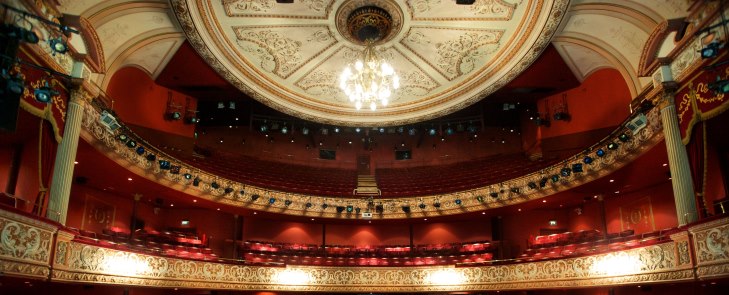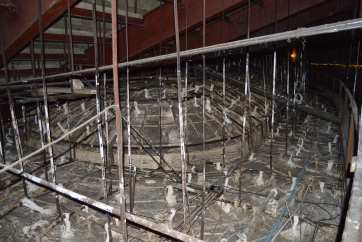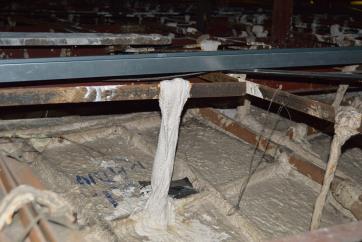Maintaining Large Fibrous Plaster Ceilings
Ronnie Clifford
 |
|
| The auditorium of the Wolverhampton Grand Theatre (Photo: Jonathan Hipkiss/Wolverhampton Grand Theatre) |
The ceiling collapse at the Apollo Theatre in London’s West End in December 2013 highlighted the urgent need to effectively monitor and maintain large suspended fibrous plaster ceilings in hundreds of theatres and other public buildings across the UK. Over 80 theatre-goers at the Shaftesbury Avenue venue were injured, seven seriously, when the roof caved in during a packed performance. The collapse could easily have resulted in fatalities and was a wake-up call for the UK’s theatre sector, which has been digesting the ramifications ever since.
Initial investigations by Westminster City Council, published in March 2014, cited weakening hessian wadding embedded in the ceiling as the cause of the collapse and recommended the urgent inspection of all suspended ornate ceilings in the city’s public buildings.
Hessian is a type of sackcloth which was mixed into the plaster of Paris as a simple but effective form of fibrous reinforcement, both for the ceiling itself and for the wadding ties which bound the ceiling to the fixings above. It was thought that the waddings at the Apollo had been in place since 1901 when the Grade II listed theatre opened its doors for the first time, and that they had become progressively weaker.
HISTORY OF FIBROUS PLASTERWORK
While the practice of reinforcing gypsum plaster with hessian and canvas has been around for millennia and is thought to predate the ancient Egyptian civilisation, the modern approach to fibrous plasterwork in the UK originates in the mid-1850s. In 1856 French modeller Leonard Desachy patented a method for the production of ‘architectural mouldings, ornaments and other works of art formed with surfaces of plaster’. It covered the use of a number of materials including plaster, glue, oil, wood, wire and woven fabric.
Desachy’s method involved the fixing of moulded surfaces to other surfaces using wires laid into and between two or more layers of canvas. Flat surfaces were strengthened with canvas, wire, hooks or pieces of wood inserted into the plaster while it was malleable. This approach soon became popular across the Channel in London, where Desachy established a manufacturing base for fibrous plaster decorations. Architect Owen Jones, author of The Grammar of Ornament (1856), became one of its first patrons. Over the past 160 years the underlying principles have changed little although the methods and materials used have evolved with time.
Compared with solid plaster, fibrous plaster offered a number of benefits. It weighs far less and can easily be reinforced, allowing mouldings to be prepared either on or off site and avoiding the need to run mouldings in situ. The use of fibrous plaster allowed for a far more flexible approach to enrichment that opened up possibilities for more lavish ornamentation. As it also enabled finely decorated plasterwork to be produced much more cost effectively, fibrous plaster quickly became popular with homeowners, theatre and music hall owners, and architects, all of whom recognised the impact of incorporating grand plasterwork designs into their internal architecture. Theatres across the land were soon being transformed into ‘cathedrals of fibrous plaster architecture’ that showcased the very best craftsmanship. You only have to look up when visiting any of our Victorian and Edwardian theatres to discover the power of a decorative plaster ceiling to transform the visitor experience.
Today, venue owners or managers are responsible for ensuring that their plasterwork ceilings are routinely checked by specialist contractors. If the ceiling is deemed safe, the contractors issue a ceiling safety certificate, which is then reviewed by the local authority alongside the venue’s other licence requirements.
DURABILITY
The organic materials used to reinforce plaster are susceptible to moulds and fungi such as dry rot. In addition, in most pre-1935 theatres the plaster was suspended from timber struts, which offered plenty of scope for attack by both fungal decay and insect pests such as woodworm, often causing irreparable damage to a building’s fabric. However, both fungal and insect decay can only flourish in a damp environment.
Suspended theatre ceilings built after 1935 generally adopted a different and more secure type of attachment involving more metalwork rather than timber and wadding made from hessian and plaster. These ‘modern’ ceilings are less likely to fail.
 |
 |
|
| Above left: the back of a suspended fibrous plaster ceiling showing the hessian and plaster ceiling ties or ‘waddings’ which bind the ceiling to the fixings above it. Above right: new ceiling ties with reinforcing wire. | ||
In the case of the Apollo Theatre, moisture was not cited as a cause of the failure of the hessian ties as the roof area was found to be dry. However, the hessian ties have a service life of around 80 years so the ties at the Apollo Theatre were long overdue for a close inspection and overhaul. Preventive maintenance is therefore a critical consideration when it comes to the conservation of fibrous plasterwork.
It should also be noted that visual inspection alone may not be enough to identify the failure of the hessian ties. Because the hessian is encased in plaster, the ties may appear sound even though the hessian inside has weakened or completely deteriorated leaving an ‘empty egg shell’ of plaster. Further intrusive investigation is required to ascertain stability.
PRESERVATION OF FIBROUS PLASTER
The findings of the Association of British Theatre Technicians (ABTT) inquiry will be felt in more than 300 listed theatres around the UK according to The Theatres Trust, whose director Mhora Samuel noted:
Many of these ceilings will also have been strengthened with wire ties and, as a result, will be very secure. A full nationwide survey will be needed to establish the number of theatres affected including unlisted theatres. Those constructed from the mid-19th century to before the second world war will be particularly affected.
In March 2014 the ABTT established a panel of 38 experts including specialist plasterers, structural engineers, acousticians, health and safety experts, architects and key industry organisations. Historic England (then part of English Heritage), the Health & Safety Executive and the Building Research Establishment were involved from the outset so it was clear that their findings would have a great deal of influence. The Theatres Trust, founded in 1976, also became involved in an advisory capacity.
Defining the true nature of suspended fibrous plaster ceilings was an initial priority and the panel concluded that there are two distinct parts: the plasterwork and the framework, each of which should be securely fastened to the other as well as to the building structure itself. This led to a first principle:
All ceilings should be inspected by two competent persons, one expert in the condition of the structure (a structural engineer) and the other an expert in the condition of the plasterwork (a plaster surveyor or a plaster contractor familiar with the inspection of heritage buildings).
Determining the competence of the inspectors was a key priority for the ABTT. While structural engineers have relatively clear-cut qualification criteria, the same cannot be said of plasterers, often artisans with extensive on-the-job experience but little in the way of widely accepted accreditation of competence.
 |
| Newly restored art deco ornate plaster ceiling at the Hammersmith Apollo, London (Photo: T Cronin) |
There is just a handful of specialist plastering firms nationwide with the knowledge and expertise to carry out this kind of sensitive investigation. A formal qualification may be in the offing for fibrous plastering but nothing comes close to the practical knowledge gained from working on historic buildings. Theatres are therefore advised to ‘undertake independent assessments of the competence of plaster specialists’ (ABTT Guidance Note 20, see Further Information).
The second principle proposed by ABTT involves ceiling inspections taking place, from both above and below, to ensure the integrity of the attachments. Any specialist plastering firm will know that inspections from above can be very difficult to carry out. Often relying on the construction of inspection hatches, many of these investigations have to take place from a distance and the importance of ensuring these ceiling areas remain free of debris and the build up of dust cannot be taken lightly.
Theatre owners on the ABTT panel were consulted about this major consideration and practical methods established to make ‘above’ inspections far more accessible. This is where the experience of an expert plasterer really comes into its own. In the short term, theatres where inspections from above cannot be carried out, should seek to mitigate any risk of falling plasterwork with the erection of netting.
The ABTT also concluded that pyrotechnics and acoustics, when managed and delivered effectively, have no negative effect on the fibrous plaster in a theatre despite the ever-growing power of sound systems.
The overarching and immediate priority, however, is for theatre owners to find out whether unreinforced wadding ties form part of their suspended ceilings with steps taken to strengthen the ties ‘as soon as is reasonably practicable’ if it is proven to be the case.
Of course, it’s not just theatres which have suspended ceilings. There are thought to be hundreds of public heritage buildings around the UK for which the ABTT findings are equally relevant and we should be mindful that these venues are also at risk.
In May 2015, almost 18 months after the Apollo Theatre ceiling collapse and following a year-long investigation, the ABTT published guidance on how to inspect, certify and record the condition of suspended fibrous plaster ceilings (see Further Information). The procedures outlined in the guidance are being trialled by the Society of London Theatre. The comprehensive guidance has drawn on the experience of many experts and therefore carries much weight and influence.
It is predicted that the cost of the recommended inspection checks could come in at around £15 million, or £15,000 for every theatre – a tough ask for organisations that are frequently sailing financially close to the wind. However, if we are to avoid the kind of scenario played out at the Apollo Theatre in December 2013, then the ABTT recommendations need to be applied in full. It is a small price to pay to ensure that stage productions around the UK can continue to securely and safely ‘raise the roof’.
~~~
Further Information
The Association of British Theatre Technicians, ABTT Guidance Note 20: Suspended Fibrous Plaster Ceilings, London, 2015
The Finishes and Interiors Sector (FIS unites previous organisations the Association of Interior Specialists and the Federation of Plastering and Drywall Contractors)
D Harrison, ‘Dramatic Plasterwork: Fibrous Plaster in Theatres’, The Building Conservation Directory, Cathedral Communications, Tisbury, 1999
W Millar, Plastering: Plain and Decorative, (1897), Donhead, Shaftesbury, 1998



